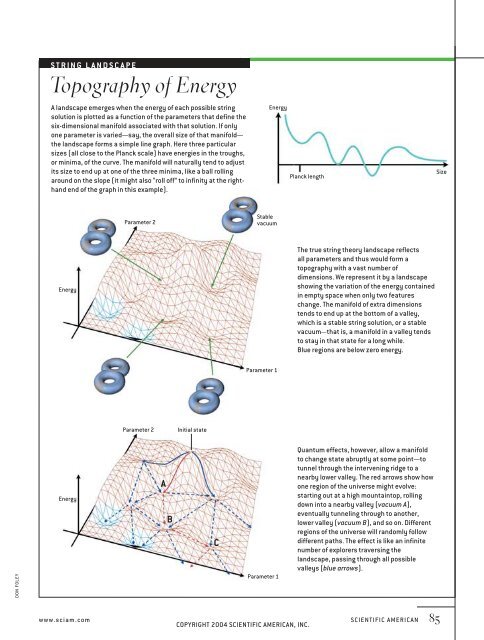The String Theory Landscape
The String Theory Landscape
The String Theory Landscape
Create successful ePaper yourself
Turn your PDF publications into a flip-book with our unique Google optimized e-Paper software.
STRING LANDSCAPE<br />
Topography of Energy<br />
A landscape emerges when the energy of each possible string<br />
solution is plotted as a function of the parameters that define the<br />
six-dimensional manifold associated with that solution. If only<br />
one parameter is varied—say, the overall size of that manifold—<br />
the landscape forms a simple line graph. Here three particular<br />
sizes (all close to the Planck scale) have energies in the troughs,<br />
or minima, of the curve. <strong>The</strong> manifold will naturally tend to adjust<br />
its size to end up at one of the three minima, like a ball rolling<br />
around on the slope (it might also “roll off” to infinity at the righthand<br />
end of the graph in this example).<br />
Energy<br />
Planck length<br />
Size<br />
Parameter 2<br />
Stable<br />
vacuum<br />
Energy<br />
<strong>The</strong> true string theory landscape reflects<br />
all parameters and thus would form a<br />
topography with a vast number of<br />
dimensions. We represent it by a landscape<br />
showing the variation of the energy contained<br />
in empty space when only two features<br />
change. <strong>The</strong> manifold of extra dimensions<br />
tends to end up at the bottom of a valley,<br />
which is a stable string solution, or a stable<br />
vacuum—that is, a manifold in a valley tends<br />
to stay in that state for a long while.<br />
Blue regions are below zero energy.<br />
Parameter 1<br />
Parameter 2<br />
Initial state<br />
DON FOLEY<br />
Energy<br />
A<br />
B<br />
C<br />
Parameter 1<br />
Quantum effects, however, allow a manifold<br />
to change state abruptly at some point—to<br />
tunnel through the intervening ridge to a<br />
nearby lower valley. <strong>The</strong> red arrows show how<br />
one region of the universe might evolve:<br />
starting out at a high mountaintop, rolling<br />
down into a nearby valley (vacuum A),<br />
eventually tunneling through to another,<br />
lower valley (vacuum B), and so on. Different<br />
regions of the universe will randomly follow<br />
different paths. <strong>The</strong> effect is like an infinite<br />
number of explorers traversing the<br />
landscape, passing through all possible<br />
valleys (blue arrows).<br />
www.sciam.com SCIENTIFIC AMERICAN 85<br />
COPYRIGHT 2004 SCIENTIFIC AMERICAN, INC.

















